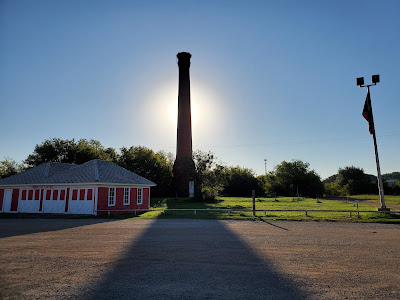Archeology in Thurber
Archeology in Thurber
By Mary Adams
October is
known as Archeology month and with it right around the corner, I wanted to take
a minute and talk about the archeology of Thurber, Texas. If you are familiar
with Thurber you recognize the remains of the Historic Smokestack on the side
of I-20 that sits half-way between Fort Worth and Abilene. It and the
restaurant which share a parking lot are two of the most prominent remains from
Thurber left standing. But what else is left and what can we learn from it?
 |
| Thurber's Smokestack. Photo Credit, Mary Adams |
Join me as I explore what was once the downtown area of Thurber. As one walks around the parking lot in front of the Smokestack Restaurant you only have to look around to spot the archeological remains. We can start with the iconic smokestack that has stood for over 100 years. This is what is left of the electric plant and ice plant. The Texas Pacific Coal Company that built Thurber decided to provide electricity to every home in Thurber and thus operated their own electric plant. Those who lived in Thurber could have electricity in their home at the cost of $0.25 per drop per month.
 |
| Remaining Spur. Photo Credit, Mary Adams |
Crossing the
parking lot towards the east end of the restaurant, if you look carefully, you
can find the remains of a rail line. This was a spur that was used to bring
inventory for the Texas Pacific Mercantile operations into town. The train cars
could be parked outside of the General Mercantile Store, currently the
restaurant, or the Hardware Store which sat across the road from the
Mercantile. The stores in Thurber were said to be some of the best supplied
stores in the area and carried everything from cutlery to wagons.
 |
| A view of downtown Thurber. Studdard Collection, W.K. Gordon Center. |
The Smokestack restaurant occupies the newest addition of the General Mercantile store. Following a fire in 1903 the company built a new brick mercantile building. The portion that stands today was and addition that was completed in 1906. Now walk down the historic brick sidewalk to the west and you will pass the remains of office buildings. These buildings housed the offices for the Texas Pacific Mercantile Operations.
As you cross the parking lot on the west end of the building you can see the footprint of a gas station that once stood in the center. Before the gas station was built there, this was common area that included a bandstand. If you would like to see the band stand stop off at the Thurber Historical Park across the interstate, where it stands today.
 |
| Barber shop remains, Photo Credit Mary Adams |
Continue
across the parking lot to the metal pipe fence and you will find remains that
include white octagonal floor tile. This is where the barber shop was located.
I can just imagine miners leaned back in a barber shop chair receiving a shave
and haircut. Can you? Perhaps after their hair cut they would stop by the Drug
Store next door and get something from the soda fountain located inside.
There are
many more remains of Thurber that dot the country side in and around the iconic
smokestack. Footprints of past buildings, bricks from supports that have
crumbled, piles of debris from digging the mines, and maybe even a rusted
chamber pot from years past. These are all remnants of a once bustling town
were people from multiple nationalities came together to live and work.

